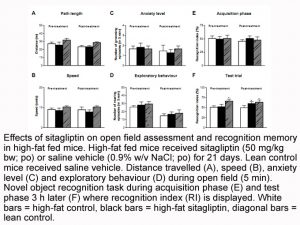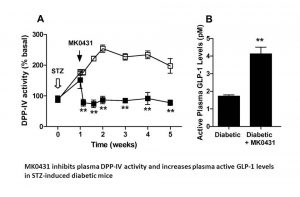| CAS NO: | 654671-77-9 |
| 规格: | ≥98% |
| 包装 | 价格(元) |
| 500mg | 电议 |
| 1g | 电议 |
| 2g | 电议 |
| 5g | 电议 |
| 10g | 电议 |
| 25g | 电议 |
| Molecular Weight (MW) | 523.32 |
|---|---|
| Formula | C16H15F6N5O.H3PO4.H2O |
| CAS No. | 654671-77-9 (Phosphate hydrate); |
| Storage | -20℃ for 3 years in powder form |
| -80℃ for 2 years in solvent | |
| Solubility (In vitro) | DMSO: 100 mg/mL (191.1 mM) |
| Water: 41 mg/mL (78.3 mM) | |
| Ethanol: <1 mg/mL | |
| Solubility (In vivo) | Saline: 30 mg/mL |
| Synonyms | MK 431; Sitagliptin Phosphate; MK-0431; MK0431; MK 0431;Sitagliptin Phosphate Monohydrate; MK-431; MK431; trade name: Januvia Xelevia Janumet Chemical Name: (R)-3-amino-1-(3-(trifluoromethyl)-5,6-dihydro-[1,2,4]triazolo[4,3-a]pyrazin-7(8H)-yl)-4-(2,4,5-trifluorophenyl)butan-1-one Phosphate Monohydrate. InChi Key: GQPYTJVDPQTBQC-KLQYNRQASA-N InChi Code: InChI=1S/C16H15F6N5O.H3O4P.H2O/c17-10-6-12(19)11(18)4-8(10)3-9(23)5-14(28)26-1-2-27-13(7-26)24-25-15(27)16(20,21)22;1-5(2,3)4;/h4,6,9H,1-3,5,7,23H2;(H3,1,2,3,4);1H2/t9-;;/m1../s1 SMILES Code: O=C(N1CC2=NN=C(C(F)(F)F)N2CC1)C[C@H](N)CC3=CC(F)=C(F)C=C3F.O=P(O)(O)O.[H]O[H] |
| In Vitro | In vitro activity: As an orally active agent, Sitagliptin phosphate exhibits a potent inhibitory effect on DPP-4 with IC50 of 19 nM from Caco-2 cell extracts. MK0431 reduces in vitro migration of isolated splenic CD4 T-cells through a pathway involving cAMP/PKA/Rac1 activation. A recent study demonstrates that sitagliptin exerts a novel, direct action in order to stimulate GLP-1 secretion by the intestinal L cell through a DPP-4-independent, protein kinase A- and MEK-ERK1/2-dependent pathway. It therefore reduces the effect of autoimmunity on graft survival. Kinase Assay: DPP-4 is extracted from confluent Caco-2 cells. After 5 minutes of incubation at room temperature with lysis buffer (10 mM Tris-HCl, 150 mM NaCl, 0.04 U/mL aprotinin, 0.5% Nonidet P40, pH 8.0), cells are centrifuged at 35,000 g at 4 °C for 30 minutes, and the supernatant is stored at -80°C. Assays are performed by mixing 20 μL of appropriate compound dilutions with 50 μL of the substrate for the DPP-4 enzyme, H-Ala-Pro-7-amido-4-trifluoromethylcoumarin (final concentration in the assay, 100 μM) and 30 μL of the Caco-2 cell extract (diluted 1000-fold with 100 mM Tris-HCl, 100 mM NaCl, pH 7.8). Plates are incubated at room temperature for 1 hour, and fluorescence is measured at excitation/emission wavelengths of 405/535 nm using a SpectraMax GeminiXS. Dissociation kinetics of inhibitors from the DPP-4 enzyme is determined after a 1-hour preincubation of Caco-2 cell extracts with high inhibitor concentrations (30 nM for BI 1356, 3 μM for vildagliptin). The enzymatic reaction is started by adding the substrate H-Ala-Pro-7-amido-4-trifluoromethylcoumarin after a 3000-fold dilution of the preincubation mixture with assay buffer. Under these conditions, the difference in DPP-4 activity at a certain time point in the presence or absence of an inhibitor reflects the amount of this inhibitor still bound to the DPP-4 enzyme. Maximal reaction rates (fluorescence units/seconds × 1000) at 10-minute intervals are calculated using the SoftMax software of the SpectraMax and corrected for the rate of an uninhibited reaction [(vcontrol-vinhibitor)/vcontrol]. Cell Assay: CD4T-cells are plated on membrane inserts in serum-free RPMI 1640, and cell migration is assayed using Transwell chambers (Corning), in the presence or absence of purified porcine kidney DPP-4 (32.1 units/mg; 100 mU/mL final concentration) and DPP-4 inhibitor (100 μM). After 1 hour, cells on the upper surface are removed mechanically, and cells that have migrated into the lower compartment are counted. The extent of migration is expressed relative to the control sample. |
|---|---|
| In Vivo | In vivo, the ED50 value of Sitagliptin phosphate for inhibition of plasma DPP-4 activity is calculated to be 2.3 mg/kg 7 hour postdose and 30 mg/kg 24 hour postdose in freely fed Han-Wistar rats. The streptozotocin-induced type 1 diabetes mouse model exhibits elevated DPP-4 levels in the plasma that can be substantially inhibited in mice on an Sitagliptin phosphate diet. This is achieved by a positive effect on the regulation of hyperglycemia, potentially through prolongation of islet graft survival. The plasma clearance and volume of distribution of Sitagliptin phosphate are higher in rats (40-48 mL/min/kg, 7-9 L/kg) than in dogs (9 mL/min/kg, 3 L/kg); and its half-life is shorter in rats,2 hours compared with 4 hours in dogs. |
| Animal model | Freely fed Han-Wistar rats |
| Formulation & Dosage | Dissolved in 0.5% aqueous hyroxyethylcellulose; 30 mg/kg; p.o. administration |
| References | J Pharmacol Exp Ther. 2008 Apr;325(1):175-82; Diabetes. 2009 Mar;58(3):641-51. |
|
|
|
 |  |  |
